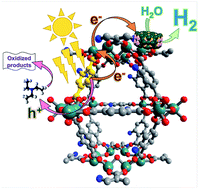Photocatalytic hydrogen generation from a visible-light responsive metal–organic framework system: the impact of nickel phosphide nanoparticles†
Abstract
Herein, we report the performance of a photocatalytic system based on visible-light active MIL-125-NH2 mixed with nickel phosphide (Ni2P) nanoparticles. This combination boosts the H2 evolution rate to an outstanding value of 894 μmol h−1 g−1 under visible-light irradiation, which is among the highest H2 evolution rates reported to date for metal–organic frameworks (MOFs). The H2 generation rate exhibited by Ni2P/MIL-125-NH2 is almost 3 times higher than that of the Pt/MIL-125-NH2 system, highlighting the impact of the co-catalyst on photocatalytic water splitting. Additionally, our system outperforms the Ni2P/TiO2 system under UV-vis irradiation. The exceptional performance of Ni2P/MIL-125-NH2 is due to the efficient transfer of photogenerated electrons from MIL-125-NH2 to Ni2P, high intrinsic activity of Ni2P and exceptional synergy between them. This system exhibits the highest apparent quantum yields of 27.0 and 6.6% at 400 and 450 nm, respectively, ever reported for MOFs.



 Please wait while we load your content...
Please wait while we load your content...